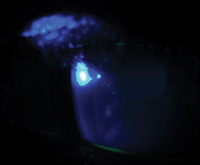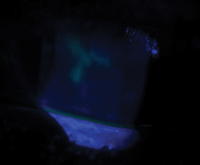 History
History
A 48-year-old black male presented to the emergency department for follow-up care after being seen by an ophthalmologist.
His chief complaint was discomfort in his left eye, which was accompanied by both watering and light sensitivity.
His systemic history was unremarkable, and he reported no known allergies.
His current medications included 500mg Valtrex (valacyclovir, GlaxoSmithKline) t.i.d. and erythromycin ointment O.S. qhs, which presumably were prescribed by the ophthalmologist for a herpetic simplex outbreak.
Diagnostic Data
His best-corrected visual acuity was 20/20 O.D. and 20/25 O.S. External examination was normal, and there was no evidence of afferent pupillary defect O.U. An anterior chamber reaction was observed O.S.
His intraocular pressure measured 16mm Hg O.U. The dilated fundus exam was normal, with quiet nerves, grounds and peripheries O.U. The pertinent anterior segment examination findings are illustrated in the photographs.
Your Diagnosis
How would you approach this case? Does this patient require any additional tests? What is your diagnosis? How would you manage this patient?
What’s the likely prognosis?
Discussion
Additional testing included sodium fluorescein staining, rose bengal staining, corneal sensitivity testing and photodocumentation. Culturing was possible, but wasn’t performed in this instance.
The diagnosis in this case is unresolved herpes simplex keratitis (HSK). While the diagnosis of herpetic keratitis is no mystery, there is controversy as to whether these lesions can be treated with oral antiviral medications alone.1-3
Herpetic keratitis is a common cause of ocular morbidity, and the most common cause of corneal blindness.4 Prompt treatment of HSK reduces the risk of visually debilitating scarring and permanent visual disability. Risks for permanent visual loss increase with each recurrent episode.5
Some practitioners embrace the use of oral preparations alone for the treatment of HSK, citing favorable compliance.1-3 In addition to a lack of definitive research refuting this therapeutic approach, several studies indicated that oral medications do, in fact, reach therapeutic levels in the tears.1-3,6 It remains unclear, however, whether these medications work by reducing the viral load in the ciliary ganglion or by curtailing viral replication.


Our patient’s left eye at initial presentation (top) and three days after we began therapeutic intervention. What is your diagnosis?
Nonetheless, researchers associated with the National Eye Institute’s Herpetic Eye Disease Study (HEDS) determined that oral antiviral preparations should be used as adjunct preventative therapy—rather than a first-line, stand-alone treatment option.5,7
More specifically, the HEDS I researchers determined:
- Topical prednisolone sodium phosphate was beneficial in patients with stromal keratitis, so long as it was initiated under the cover of topical antiviral medication (Viroptic [trifluridine, Monarch Pharmaceuticals]).
- Oral preparations (Zovirax [acyclovir, GlaxoSmithKline]) had no added benefit in resolving or preventing stromal keratitis when added to the regimen of topical antiviral and steroid medications.
- Oral antiviral preparations may have the ability to reduce the course of the resultant iritis.8
- Four hundred milligrams of prophylactic oral acyclovir used b.i.d. over a 12-month period decreased the recurrence rate of any form of herpetic ocular infection by 45% within that year (including a 50% reduction in the recurrence of stromal keratitis).6
- There was no therapeutic benefit to adding an oral antiviral medication when attempting to prevent progression from HSK to stromal disease.7
- At the time of the study, the researchers found no evidence indicating that certain risk factors, such as extreme cold or heat, fatigue, illness or sun exposure, could trigger a recurrence of herpetic disease.7
The current standard of care for HSK includes topical cycloplegia and topical trifluridine q2h, as well as polysporin ointment for any exposed papillomacular rash.9,10 The HED studies have encouraged the addition of oral medications to this topical and dermatologic regimen in an effort to reduce the risk and course of iritis, while serving as a prophylactic over time.1-3,6,7 In the event that ocular inflammation requires treatment, HEDS I supported the application of a topical steroidal preparation, so long as the topical antiviral medication is continued at least q.i.d.6,7
Recently, topical ganciclovir became available in the United States as Zirgan (ganciclovir 0.15%, Bausch + Lomb) gel. The preparation has been in use for more than 10 years in Europe, and has been studied extensively. Zirgan’s mechanism of action uniquely targets virus-infected cells, decreasing the viral load while sparing normal corneal cells reducing corneotoxicity.11,12 The drug penetrates into the corneal stroma and reaches therapeutic levels in the aqueous humor.13
In this case, we prescribed in-office cycloplegia using 5% homatropine, as well as Zirgan gel five times per day. Additionally, we asked the patient to continue using oral valacyclovir. At the follow-up three days later, significant clinical improvement was evident. Following lesion resolution, we promptly tapered the Zirgan to t.i.d.11 Finally, we recommended long-term maintenance dosing of the oral antiviral preparation, according to HEDS protocol.
Thanks to Alissa Coyne, O.D., of Philadelphia for contributing this case.
1. Shimomura Y. Herpes simplex virus latency, reactivation, and a new antiviral therapy for herpetic keratitis. Nihon Ganka Gakkai Zasshi. 2008 Mar;112(3):247-64; discussion 265.
2. Higaki S, Itahashi M, Deai T, et al. Effect of oral valaciclovir on herpetic keratitis. Cornea. 2006;25(10 Suppl 1):S64-7.
3. Sozen E, Avunduk AM, Akyol N. Comparison of efficacy of oral valacyclovir and topical acyclovir in the treatment of herpes simplex keratitis: a randomized clinical trial. Chemotherapy. 2006;52(1):29-31.
4. Wilhelmus KR. The treatment of herpes simplex virus epithelial keratitis. Trans Am Ophthalmol Soc. 2000;98:505-32.
5. Colin J. Ganciclovir ophthalmic gel, 0.15%: a valuable tool for treating ocular herpes. Clinical Clin Ophthalmol. 2007;1(4):441-53.
6. Wilhelmus KR. Antiviral treatment and other therapeutic interventions for herpes simplex virus epithelial keratitis. Cochrane Database Syst Rev. 2010;(12):CD002898.
7. The Herpetic Eye Disease Study Group. A controlled trial of oral acyclovir for the prevention of stromal keratitis or iritis in patients with herpes simplex virus epithelial keratitis. The Epithelial Keratitis Trial. Arch Ophthalmol. 1997;115(6):703-12.
8. Barron BA, Gee L, Hauck WW, et al. Herpetic Eye Disease Study. A controlled trial of oral acyclovir for herpes simplex stromal keratitis. Ophthalmology. 1994;101(12):1871-82.
9. Knickelbein JE, Hendricks RL, Charukamnoetkanok P. Management of herpes simplex virus stromal keratitis: an evidence-based review. Surv Ophthalmol. 2009;54(2):226-34.
10. Wilhelmus KR. Therapeutic interventions for herpes simplex virus epithelial keratitis. Cochrane Database Syst Rev. 2007;(1):CD002898.
11. Bausch + Lomb. Zirgan package insert. 2010.
12. Rajalakshmi R, Kumari R, Thappa DM. Acyclovir versus valacyclovir. Indian J Dermatol Venereol Leprol. 2010;76(4):439-44.
13. Hoh HB, Hurley C, Claoue C, et al. Randomized trial of ganciclovir and acyclovir in the treatment of herpes simplex dendritic keratitis: A multicentre study. Br J Ophthalmol. 1996;80(2):140-3.

